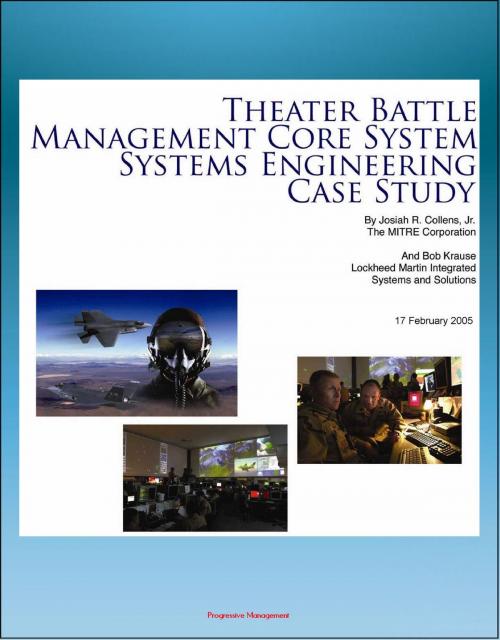Theater Battle Management Core System Systems Engineering Case Study: History and Details of TBMCS Integrated Air Command and Control System
Nonfiction, Science & Nature, Technology, Military Science, History, Military, Aviation| Author: | Progressive Management | ISBN: | 9781476203324 |
| Publisher: | Progressive Management | Publication: | July 23, 2012 |
| Imprint: | Smashwords Edition | Language: | English |
| Author: | Progressive Management |
| ISBN: | 9781476203324 |
| Publisher: | Progressive Management |
| Publication: | July 23, 2012 |
| Imprint: | Smashwords Edition |
| Language: | English |
This is one of a series of systems engineering case studies prepared by the Air Force Center for Systems Engineering. This case study analyzes the Theater Battle Management Core System (TBMCS) is an integrated air command and control (C2) system that performs standardized, secure, automated air battle planning and execution management for Air Force, multi-service, and allied commanders in theaters of operation worldwide. TBMCS provides the means to plan, direct, and control all theater air operations and to coordinate with land, maritime, and special operations elements. It is deployed at C2 nodes at national, force and wing/unit-level elements. TBMCS operates in support of planners and decision makers at, and below, the level of Joint Force Air Component Commander. The system is modular and scalable for air, land, or sea transport and the deployed configurations can be tailored to meet a particular contingency.
The Department of Defense is exponentially increasing the acquisition of joint complex systems that deliver needed capabilities demanded by our warfighter. Systems engineering is the technical and technical management process that focuses explicitly on delivering and sustaining robust, high-quality, affordable solutions. The Air Force leadership has collectively stated the need to mature a sound systems engineering process throughout the Air Force. Gaining an understanding of the past and distilling learning principles that are then shared with others through our formal education and practitioner support are critical to achieving continuous improvement. These cases support academic instruction on SE within military service academies, civilian and military graduate schools, industry continuing education programs, and those practicing SE in the field. Each of the case studies is comprised of elements of success as well as examples of SE decisions that, in hindsight, were not optimal.
EXECUTIVE SUMMARY * Chapter 1 * SYSTEMS ENGINEERING PRINCIPLES * 1.1 General Systems Engineering Process * 1.2 TBMCS Major Learning Principles * Chapter 2 * SYSTEM DESCRIPTION * 2.1 TBMCS Functional Overview * 2.2 Air Battle Plan Rhythm * Chapter 3 * TBMCS SYSTEMS ENGINEERING LEARNING PRINCIPLES * 3.1 Learning Principle 1 - Requirements Definition and Management * 3.2 Learning Principle 2 - Systems Architecture * 3.3 Learning Principle 3 - System/Subsystem Design * 3.4 Learning Principle 4 - System Integration and Test * 3.5 Learning Principle 5 - Validation and Verification * Chapter 4 * SUMMARY * Chapter 5 * REFERENCES * Chapter 6
This is one of a series of systems engineering case studies prepared by the Air Force Center for Systems Engineering. This case study analyzes the Theater Battle Management Core System (TBMCS) is an integrated air command and control (C2) system that performs standardized, secure, automated air battle planning and execution management for Air Force, multi-service, and allied commanders in theaters of operation worldwide. TBMCS provides the means to plan, direct, and control all theater air operations and to coordinate with land, maritime, and special operations elements. It is deployed at C2 nodes at national, force and wing/unit-level elements. TBMCS operates in support of planners and decision makers at, and below, the level of Joint Force Air Component Commander. The system is modular and scalable for air, land, or sea transport and the deployed configurations can be tailored to meet a particular contingency.
The Department of Defense is exponentially increasing the acquisition of joint complex systems that deliver needed capabilities demanded by our warfighter. Systems engineering is the technical and technical management process that focuses explicitly on delivering and sustaining robust, high-quality, affordable solutions. The Air Force leadership has collectively stated the need to mature a sound systems engineering process throughout the Air Force. Gaining an understanding of the past and distilling learning principles that are then shared with others through our formal education and practitioner support are critical to achieving continuous improvement. These cases support academic instruction on SE within military service academies, civilian and military graduate schools, industry continuing education programs, and those practicing SE in the field. Each of the case studies is comprised of elements of success as well as examples of SE decisions that, in hindsight, were not optimal.
EXECUTIVE SUMMARY * Chapter 1 * SYSTEMS ENGINEERING PRINCIPLES * 1.1 General Systems Engineering Process * 1.2 TBMCS Major Learning Principles * Chapter 2 * SYSTEM DESCRIPTION * 2.1 TBMCS Functional Overview * 2.2 Air Battle Plan Rhythm * Chapter 3 * TBMCS SYSTEMS ENGINEERING LEARNING PRINCIPLES * 3.1 Learning Principle 1 - Requirements Definition and Management * 3.2 Learning Principle 2 - Systems Architecture * 3.3 Learning Principle 3 - System/Subsystem Design * 3.4 Learning Principle 4 - System Integration and Test * 3.5 Learning Principle 5 - Validation and Verification * Chapter 4 * SUMMARY * Chapter 5 * REFERENCES * Chapter 6















